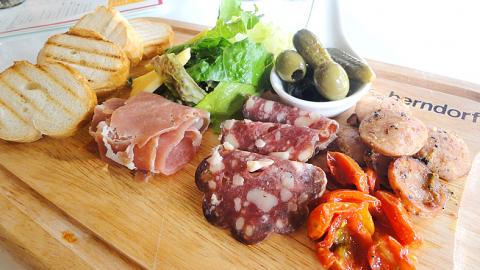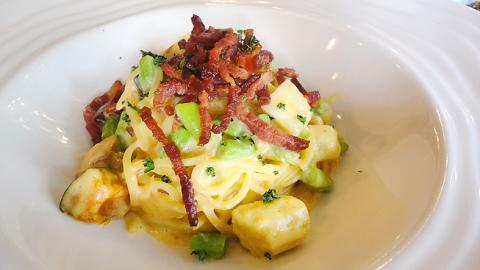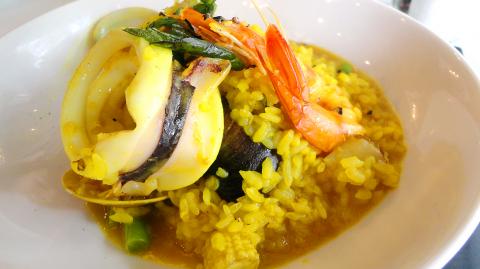Conveniently located near Taipei’s Renai Road traffic circle, Winona serves a range of Western-style dishes such as pasta, pizza, risotto and steak, as well as wines galore.
The rows of macaroons displayed in the dessert refrigerator at the door make Winona seem pricy and inaccessible. But the glass wall near the entrance reduces the distance between potential customers and the restaurant by allowing passersby to look inside at the diners.
The menu has more than a dozen hot and cold appetizers, many of them marked as new additions. Options include Baja-flavored shrimp and tomato skewers (NT$180), blue cheese chicken rolls (NT$100) and chef’s special salmon and vegetable rolls (NT$180). The expected appetizers, such as French fries (NT$80) and assorted cheese platter (large for NT$300 and small for NT$180), are also available.

Photo: Tang Hsiang-yi, Taipei Times
Our party started off with the tapas platter (NT$250). A wooden tray arrived with nicely arranged cold cuts along with pickles, olives, pieces of bread, lettuce, cheese and marinated tomatoes. The salami, smoked sausage and Parma ham tasted authentic and started off the meal on a pleasant note.
Having heard positive feedback on Winona’s beef bourguignon (NT$330), I was hoping to try it. When I saw the menu, I noticed that this French beef stew is listed as a dinner entree. After expressing my interest in having the dish at lunch, the waitress said that during lunchtime, beef bourguignon is only available in the set menu for two (NT$1,680). The menu includes up to six choices of house wines, appetizers and main dishes; diners choose two from each category.
I didn’t take the server’s advice. Instead, we ordered a la carte main entrees of Hungarian risotto (NT$330), seafood risotto in tomato sauce (NT$330) and spaghetti carbonara (NT$250). The carbonara won my heart with its enticing presentation of bacon strips and mixture of creaminess and saltiness.

Photo: Tang Hsiang-yi, Taipei Times
Both versions of the risotto included sea bass, shrimp, clams and calamari. Turmeric gave the Hungarian risotto an earthy yellow hue, while tomatoes turned the other one red.
They both looked better than they tasted. Not yet al dente, the rice was clumpy and more soggy than creamy. The grain texture of the tomato-based risotto was so remarkably crunchy that we didn’t finish the plate. The Hungarian risotto was interesting herb-like but also a little salty.
On a happier note, Winona’s wine list offers more than 10 options — all reasonably priced. From NT$80 to NT$150 per glass, recommended wines are paired with dishes on the menu. Wine-savvy wait staff offer suggestions upon request.

Photo: Tang Hsiang-yi, Taipei Times
Although I wasn’t satisfied with the risotto, the glass of German Riesling wine (NT$150) served as a fruity compensation.
Wine pairings for food are often priced with big markups, due to expense that restaurants incur to bring in the wine. But Winona is owned by a wine importer; hence it offers a vast selection of wine at retail price. Winona also has a wine cellar and invites diners to handpick their favorite bottle.
To bring the meal to a happy end, we ordered the waffle with banana, chocolate, almond and ice cream (NT$180). The firm waffle was garnished with banana slices and chocolate sauce — a combination that seldom goes wrong.

Photo: Tang Hsiang-yi, Taipei Times

Many people noticed the flood of pro-China propaganda across a number of venues in recent weeks that looks like a coordinated assault on US Taiwan policy. It does look like an effort intended to influence the US before the meeting between US President Donald Trump and Chinese dictator Xi Jinping (習近平) over the weekend. Jennifer Kavanagh’s piece in the New York Times in September appears to be the opening strike of the current campaign. She followed up last week in the Lowy Interpreter, blaming the US for causing the PRC to escalate in the Philippines and Taiwan, saying that as

US President Donald Trump may have hoped for an impromptu talk with his old friend Kim Jong-un during a recent trip to Asia, but analysts say the increasingly emboldened North Korean despot had few good reasons to join the photo-op. Trump sent repeated overtures to Kim during his barnstorming tour of Asia, saying he was “100 percent” open to a meeting and even bucking decades of US policy by conceding that North Korea was “sort of a nuclear power.” But Pyongyang kept mum on the invitation, instead firing off missiles and sending its foreign minister to Russia and Belarus, with whom it

The Chinese Communist Party (CCP) has a dystopian, radical and dangerous conception of itself. Few are aware of this very fundamental difference between how they view power and how the rest of the world does. Even those of us who have lived in China sometimes fall back into the trap of viewing it through the lens of the power relationships common throughout the rest of the world, instead of understanding the CCP as it conceives of itself. Broadly speaking, the concepts of the people, race, culture, civilization, nation, government and religion are separate, though often overlapping and intertwined. A government

Nov. 3 to Nov. 9 In 1925, 18-year-old Huang Chin-chuan (黃金川) penned the following words: “When will the day of women’s equal rights arrive, so that my talents won’t drift away in the eastern stream?” These were the closing lines to her poem “Female Student” (女學生), which expressed her unwillingness to be confined to traditional female roles and her desire to study and explore the world. Born to a wealthy family on Nov. 5, 1907, Huang was able to study in Japan — a rare privilege for women in her time — and even made a name for herself in the